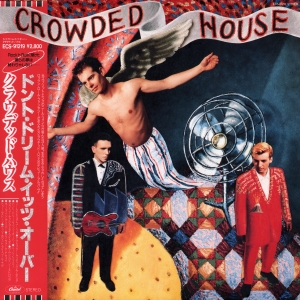

Crowded House
Studio album by Crowded House
Released June 1986
Recorded Late 1985-Early 1986, Sunset Sound
Genre Rock, pop rock, alternative rock
Length 38:40
Label Capitol/EMI
Producer Mitchell Froom
Professional reviews
* Allmusic 3.5/5 stars link
* Robert Christgau C+ link
Crowded House is the self-titled debut album by the band Crowded House. It was released in 1986 and produced by Mitchell Froom. The album was the first to feature band-leader Neil Finn following the break-up of his previous group Split Enz. The album includes the hit singles "Don't Dream It's Over", "Something So Strong", "Mean to Me", "World Where You Live" and "Now We're Getting Somewhere", the first four of which were included on the group's first greatest hits album Recurring Dream.
History
Following the break up of Split Enz in 1984, Neil Finn and drummer Paul Hester decided to form a band. Bass player Nick Seymour approached Finn during the after party for the Melbourne show of Split Enz farewell tour and asked if he could try out for the new band. Former Swingers and soon-to-be Midnight Oil bass player Bones Hillman was also a candidate, but it was Seymour's playing on the demo for "That's What I Call Love" that earned him the spot. The group, then named The Mullanes, also included The Reels guitarist Craig Hooper, who left the band before they signed with Capitol Records. Capitol rejected the name "The Mullanes", as well as alternatives such as "Largest Living Things". The name Crowded House was adopted after the trio flew to Los Angeles to record the album and were provided with a very cramped apartment to live in.
The album's rhythm tracks were recorded by Larry Hirsh at Capitol Recording Studios, Los Angeles. The remaining recording sessions for the album were at Sunset Sound studios, where the group first collaborated with engineer Tchad Blake who also worked on the next two Crowded House albums. The album was mixed by Michael Frondelli at Studio 55. Seymour and Hester do not appear on "Now We're Getting Somewhere", which was recorded early in the sessions with drummer Jim Keltner and bass player Jerry Scheff.
The original New Zealand and Australia release of the album featured ten tracks, however when the album was being prepared for export it was decided to include Crowded House's version of the Split Enz song "I Walk Away". At the same time the track listing was re-ordered and the song "Can't Carry On" was dropped from the album. After the release of the band's second album, Temple of Low Men, EMI re-released Crowded House internationally, using the original Australian/New Zealand track listing but with "I Walk Away" included too. This is now considered the "standard" track listing of for the album. A DualDisc version of this album was made available in 2005. The DVD side features a DVD-A version of the album with lyrics, a discography and the music videos for "Don't Dream It's Over" and "Something So Strong."
The album peaked at #1 in Australia, #3 in New Zealand and #12 on the US Billboard 200 chart. It has been certified platinum in Australia (x7), New Zealand (x5) and Canada. In the US it was RIAA-certified gold on May 1, 1987, and platinum on November 25, 1991.
The single "Don't Dream It's Over" was an international hit that reached #2 on the US Billboard Hot 100 chart on 25 April 1987. Its enduring popularity was evident when 18 years later in 2005 it was used in TV commercials by the New Zealand Tourism Commission. The follow-up single "Something So Strong," which lent its title to a 1997 biography of Crowded House by Chris Bourke, peaked at #7 in the US. "Mean to Me", "World Where You Live", and "Now We're Getting Somewhere" were also released as singles.
"Don't Dream it's Over" reached #27 in the UK singles chart on release in May 1987, but peaked at #25 when re-released in November 1996.
Track Listings
1. "World Where You Live" (Finn) – 3:07
2. "Now We're Getting Somewhere" (Finn) – 4:09
3. "Don't Dream It's Over" (Finn) – 4:03
4. "Mean to Me" (Finn) – 3:15
5. "Love You 'Til the Day I Die" (Finn) – 3:31
6. "Something So Strong" (Finn, Froom) – 2:51
7. "Hole in the River" (Finn, Rayner) – 4:02
8. "I Walk Away" (Finn) – 3:06
9. "Tombstone" (Finn) – 3:30
10. "That's What I Call Love" (Finn, Hester) – 3:39
The original release of the album in Australia and New Zealand featured "Can't Carry On" as track 8. This song was replaced by a re-recording of the Split Enz song "I Walk Away" for other markets. Later CD re-issues of the album include both songs with the listing extended to 11 tracks.
Band
* Neil Finn – Vocals, guitar and piano
* Nick Seymour – Bass guitar
* Paul Hester – Drums and backing vocals
Additional musicians
* Tim Pierce – Guitar
* Jim Keltner – Drums ("Now We're Getting Somewhere")
* Jerry Scheff – Bass guitar ("Now We're Getting Somewhere")
* Noel Crombie – Background vocals
* Jim Gilstrap – Background vocals
* Andy Milton – Background vocals
* Joe Satriani – Background vocals
* George Bermudez – Percussion
* Heart Attack Horns – Horns
* Mitchell Froom – Keyboards
Album credits
* Mitchell Froom – Producer
* Eddie Rayner - Producer "Can't Carry On"
* Larry Hirsh – Engineer (Capitol Recording Studios sessions)
* Steve Himelfarb – Assistant engineer (Capitol Recording Studios sessions)
* Tchad Blake – Engineer (Sunset Sound Factory sessions)
* Dennis Kirk – Engineer (Sunset Sound Factory sessions)
* Michael Frondelli – Mixer (Studio 55)
* Glen Golguin – Assistant mixing engineer
* Wally Traugott – Mastering (Capitol Recording Studios)
* John O'Brien – Art direction
* Nick Seymour – Design/Cover painting
* Dennis Keeley – Photography